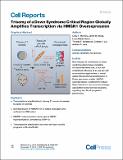| dc.contributor.author | Mowery, Cody T. | |
| dc.contributor.author | Reyes, Jaime M. | |
| dc.contributor.author | Cabal-Hierro, Lucia | |
| dc.contributor.author | Higby, Kelly J. | |
| dc.contributor.author | Karlin, Kristen L. | |
| dc.contributor.author | Wang, Jarey H. | |
| dc.contributor.author | Cejas, Paloma | |
| dc.contributor.author | Lim, Klothilda | |
| dc.contributor.author | Li, Hubo | |
| dc.contributor.author | Furusawa, Takashi | |
| dc.contributor.author | Long, Henry W. | |
| dc.contributor.author | Pellman, David | |
| dc.contributor.author | Chapuy, Bjoern | |
| dc.contributor.author | Bustin, Michael | |
| dc.contributor.author | Westbrook, Thomas F. | |
| dc.contributor.author | Lin, Charles Y. | |
| dc.contributor.author | Lane, Andrew A. | |
| dc.contributor.author | Kimmerling, Robert John | |
| dc.contributor.author | Manalis, Scott R | |
| dc.date.accessioned | 2019-03-15T18:46:32Z | |
| dc.date.available | 2019-03-15T18:46:32Z | |
| dc.date.issued | 2018-11 | |
| dc.date.submitted | 2018-08 | |
| dc.identifier.issn | 2211-1247 | |
| dc.identifier.uri | http://hdl.handle.net/1721.1/120994 | |
| dc.description.abstract | Down syndrome (DS, trisomy 21) is associated with developmental abnormalities and increased leukemia risk. To reconcile chromatin alterations with transcriptome changes, we performed paired exogenous spike-in normalized RNA and chromatin immunoprecipitation sequencing in DS models. Absolute normalization unmasks global amplification of gene expression associated with trisomy 21. Overexpression of the nucleosome binding protein HMGN1 (encoded on chr21q22) recapitulates transcriptional changes seen with triplication of a Down syndrome critical region on distal chromosome 21, and HMGN1 is necessary for B cell phenotypes in DS models. Absolute exogenous-normalized chromatin immunoprecipitation sequencing (ChIP-Rx) also reveals a global increase in histone H3K27 acetylation caused by HMGN1. Transcriptional amplification downstream of HMGN1 is enriched for stage-specific programs of B cells and B cell acute lymphoblastic leukemia, dependent on the developmental cellular context. These data offer a mechanistic explanation for DS transcriptional patterns and suggest that further study of HMGN1 and RNA amplification in diverse DS phenotypes is warranted. How trisomy 21 contributes to Down syndrome phenotypes, including increased leukemia risk, is not well understood. Mowery et al. use per-cell normalization approaches to reveal global transcriptional amplification in Down syndrome models. HMGN1 overexpression is sufficient to induce these alterations and promotes lineage-associated transcriptional programs, signaling, and B cell progenitor phenotypes. | en_US |
| dc.publisher | Elsevier | en_US |
| dc.relation.isversionof | http://dx.doi.org/10.1016/j.celrep.2018.10.061 | en_US |
| dc.rights | Creative Commons Attribution-NonCommercial-NoDerivs License | en_US |
| dc.rights.uri | http://creativecommons.org/licenses/by-nc-nd/4.0/ | en_US |
| dc.source | Elsevier | en_US |
| dc.title | Trisomy of a Down Syndrome Critical Region Globally Amplifies Transcription via HMGN1 Overexpression | en_US |
| dc.type | Article | en_US |
| dc.identifier.citation | Mowery, Cody T., Jaime M. Reyes, Lucia Cabal-Hierro, Kelly J. Higby, Kristen L. Karlin, Jarey H. Wang, Robert J. Kimmerling, et al. “Trisomy of a Down Syndrome Critical Region Globally Amplifies Transcription via HMGN1 Overexpression.” Cell Reports 25, no. 7 (November 2018): 1898–1911. © 2018 The Authors | en_US |
| dc.contributor.department | Massachusetts Institute of Technology. Department of Biological Engineering | en_US |
| dc.contributor.department | Koch Institute for Integrative Cancer Research at MIT | en_US |
| dc.contributor.mitauthor | Kimmerling, Robert John | |
| dc.contributor.mitauthor | Manalis, Scott R | |
| dc.relation.journal | Cell Reports | en_US |
| dc.eprint.version | Final published version | en_US |
| dc.type.uri | http://purl.org/eprint/type/JournalArticle | en_US |
| eprint.status | http://purl.org/eprint/status/PeerReviewed | en_US |
| dc.date.updated | 2019-02-28T13:43:25Z | |
| dspace.orderedauthors | Mowery, Cody T.; Reyes, Jaime M.; Cabal-Hierro, Lucia; Higby, Kelly J.; Karlin, Kristen L.; Wang, Jarey H.; Kimmerling, Robert J.; Cejas, Paloma; Lim, Klothilda; Li, Hubo; Furusawa, Takashi; Long, Henry W.; Pellman, David; Chapuy, Bjoern; Bustin, Michael; Manalis, Scott R.; Westbrook, Thomas F.; Lin, Charles Y.; Lane, Andrew A. | en_US |
| dspace.embargo.terms | N | en_US |
| dc.identifier.orcid | https://orcid.org/0000-0001-9939-764X | |
| dc.identifier.orcid | https://orcid.org/0000-0001-5223-9433 | |
| mit.license | PUBLISHER_CC | en_US |
